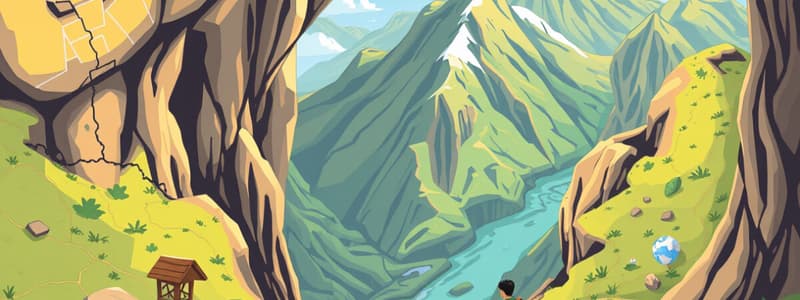Podcast
Questions and Answers
Match the following terms related to asking for directions with their definitions:
Match the following terms related to asking for directions with their definitions:
Can you help me? = Phrase used to request assistance Which way? = Question asking for the direction Excuse me = Polite way to get someone's attention Turn left = Instruction to change direction towards the left
Match the different parts of a map with their descriptions:
Match the different parts of a map with their descriptions:
Legend = Explanation of symbols used on the map Compass rose = Shows direction (North, South, East, West) Scale = Represents the proportion of distance on the map Grid = Network of lines to locate specific areas
Match the types of locations with their descriptions:
Match the types of locations with their descriptions:
Library = Place where books and information are found Park = Public area for recreation and nature School = Establishment for education and learning Restaurant = Place where meals are prepared and served
Match the following directional phrases with their meanings:
Match the following directional phrases with their meanings:
Match the common responses to requests for directions:
Match the common responses to requests for directions:
Flashcards are hidden until you start studying
Study Notes
Asking for Directions
- Understanding how to ask for directions is crucial for effective navigation in unfamiliar areas.
- Common phrases include "Excuse me, can you help me?" or "Where is...?" to initiate conversation.
- Use of polite language enhances the likelihood of receiving helpful assistance.
Parts of a Map
- Key: A legend explaining symbols used on the map.
- Scale: Indicates the relationship between distance on the map and real life.
- Compass rose: Displays the cardinal directions - North, South, East, West.
- Street names: Essential for identifying locations and planning routes.
Types of Locations
- Landmarks: Notable places which serve as reference points.
- Public spaces: Parks, squares, or plazas used for community activities.
- Commercial areas: Zones primarily filled with shops and services.
- Residential areas: Neighborhoods where people live, encompassing private homes.
Directional Phrases
- "Go straight": Continue forward without turning.
- "Turn left": Shift direction to the left at the next opportunity.
- "Take the first right": Make a right turn at the first intersection.
- "At the traffic light": A specific point to focus on when navigating.
Common Responses to Requests for Directions
- "It's just around the corner": Indicates proximity but requires some navigation.
- "You can't miss it": Suggests that the destination is very noticeable.
- "Take a bus/taxi": Suggests alternative transportation options for longer distances.
- "I’m not sure": Honest admission of uncertainty; might require further assistance.
Studying That Suits You
Use AI to generate personalized quizzes and flashcards to suit your learning preferences.




